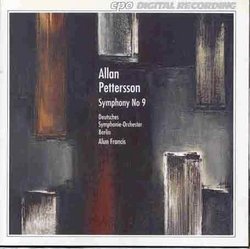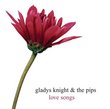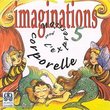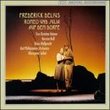| All Artists: Allan Pettersson, Alun Francis, Berliner Rundfunk-Sinfonie-Orchester, Deutsches Symphony Orchestra Berlin Title: Allan Pettersson: Symphony No. 9 Members Wishing: 1 Total Copies: 0 Label: Cpo Records Release Date: 8/23/1994 Genre: Classical Styles: Historical Periods, Modern, 20th, & 21st Century, Symphonies Number of Discs: 1 SwapaCD Credits: 1 UPC: 761203923120 |
Search - Allan Pettersson, Alun Francis, Berliner Rundfunk-Sinfonie-Orchester :: Allan Pettersson: Symphony No. 9
 | Allan Pettersson, Alun Francis, Berliner Rundfunk-Sinfonie-Orchester Allan Pettersson: Symphony No. 9 Genre: Classical
|
Larger Image |
CD DetailsSimilar CDs
|
CD ReviewsPettersson's Failure Sheridan Nofer | Mineola, New York USA | 04/28/2002 (4 out of 5 stars) "I hate to have to part company from my fellow admirers of this unusual, possibly unique, twentieth century composer, but for me the Ninth just does not cut it as a masterwork. I was "with" Pettersson up until the time I heard this work, but upon listening to it I must say a certain disappointment set in, and fairly quickly. I find it a lot of "sound and fury..."--well, you know the rest of the quote. And the final pages seem to me to be uninspired, as if Pettersson had no convincing way to end the work and tacked on what another reviewer (in Fanfare some years back) termed "a perfunctory Amen cadence." I think the composer just "wimps out" and goes soft at the end; he would never have been able to come up with a truly Mahlerian coda so he resorted to the "Amen"--Amen for what, anyway? The performance and recording are, of course, another matter; they are top-flight. On the other hand, I'm certainly not surprised no other conductor (not even Segerstam so far) has tackled this unwieldy monster. Admirers of this composer (and I continue to be one of them, though nowhere near as enthusiastic as I may have been a few years back) will no doubt wish to respond to me, but I hold to my conviction that with the Ninth, before he was finished writing it, Pettersson ran out of things to say." A Voice Crying Out Daniel R. Greenfield | Milwaukee, Wisconsin, United States | 12/12/2001 (4 out of 5 stars) "Pettersson's Ninth embodies the drama of a seemingly endless battle fought on many different fronts. Mercifully, this recording has been subdivided into 17 major "turning points" in the score. I would recommend to anyone interested in grappling with this work to start at track 10 and go from there. I say that simply because as this massive work approaches its concluding sections, there are some very beautiful and lyrical segments which may encourage the listener to make a complete exploration of this battle-scarred terrain. In fact there are treasures hidden throughout the work, but you must seek them out. What I call the "fate motif" first appears in track 11. This motif (two short notes, one long, two short, with the last two emphasized) reappears often throughout the latter portions of the work, forcefully accented by brass or percussion. Finally, in the concluding track, a canto emerges unisono on the strings: a searing, searching theme of great beauty, which leads the listener into a whole new realm. It is as if one had emerged from a battlefield and suddenly coming up over a mountain ridge encountered a beautiful vista in the distance -- inexplicable, mysterious, bearing no resemblance to the bloody battlefield below. The symphony concludes gently in a major key, with an Amen (So Be It) played softly on the winds." One of Pettersson's finest George Sdraulig | Australia | 01/16/2008 (5 out of 5 stars) "Allan Pettersson's Symphony No. 9 was written in 1970, just before he was admitted to hospital with a life threatening illness. In a superstitious sense, Pettersson was lucky to survive, as many composers before him passed away conspicuously after completing their Ninth Symphony. This controversial work is fascinating and is, in my opinion, one of Pettersson's finest.
Pettersson succeeds in creating a work, for the first time, of a material concentration that can be given great respect in an intellectual sense. The opening chromatic gesture of the symphony plays a dynamic role for everything that unfolds throughout this symphony's enormous 70 minutes. Here he achieves not just horizontal concentration, but harmonic concentration. This may be a reason why this work is superficially less accessible than its two immediate predecessors, as the thematic argument is straight-forward and never meanders. The work as a listening experience is gripping, more so than the better known Seventh Symphony (although that work is still the place to start in the Pettersson symphonic canon for those not acquainted with it). The intensity of the first 30 to 40 minutes never flags, with the composer always introducing new and interesting ideas with a greater sense of inevitability than ever before. The remaining 8 tracks of the disc begin to lead the material in a different direction, becoming less intense and leading to a more sad, complaining mood. The enormous work ends with an amen cadence which is, admittedly, something which sounds astoundingly out of place and makes one wonder how a person who produced such a masterpiece would choose to end the work like that. So be it, this is one of the great post war symphonies, but for those new to Pettersson, start with the Segerstam 7th and 11th symphonies disc, then venture to the 8th and 10th symphonies disc by the same conductor before tackling this challenging work, which is entirely worth the effort. Strongly recommended." |

 Track Listings (17) - Disc #1
Track Listings (17) - Disc #1


